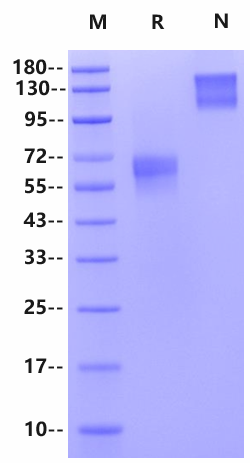60-72kDa
Reconstitute at 0.1-1 mg/ml according to the size in ultrapure water after rapid centrifugation.
1、Kane L P. (2010) T cell Ig and mucin domain proteins and immunity. J Immunol. 184(6): 2743-2749.
2、Freeman G J. et al. (2010) TIM genes: a family of cell surface phosphatidylserine receptors that regulate innate and adaptive immunity. Immunol Rev. 235(1): 172-189.
3、Zhu C. et al. (2011) TIM-3 and its regulatory role in immune responses. Curr Top Microbiol Immunol. 350: 1-15.
4、Han G. et al. (2013) Tim-3: An Activation Marker and Activation Limiter of Innate Immune Cells. Front Immunol. 4: 449.
Tim-3 proteins are members of the T cell immunoglobulin and mucin domain (Tim) family, which contains a group of type I transmembrane proteins expressed by innate and adaptive cell types within the immune system. In humans and other mammals, the Tim family consists of three proteins (TIM-1, -3, and -4). The signature feature of Tim proteins is the extracellular domain, which consists of an N-terminal immunoglobulin variable region-like (IgV) domain containing approximately 100 amino acids and a serine/threonine-rich mucinoid domain of varying lengths containing target sites for O- and N- binding glycosylation. To date, the IgV domain of Tim-3 has been shown to interact with phosphatidylserine, the alarm protein HMGB1 (high mobility frame 1), and galactosin-9 displayed on apoptotic cell surfaces, a widely expressed soluble protein that is specific to carbohydrate chains containing beta-galactosidine sugars. Tim-3 binding to phosphatidylserine mediates uptake of apoptotic cells by phagocytes expressing Tim-35. Recent studies using human primary CD8 T cells have shown that Tim-3 is associated with immune synapses formed between CD8 T cells and target cells, and that Tim-3 colocalizes with phosphatases that inhibit T cell receptor (TCR) signaling.


Immobilized Galectin-9 His Tag, Human (Cat. No. UA010431) at 5.0μg/mL (100μL/well) can bind TIM-3/HAVCR2 Fc Chimera, Cynomolgus (Cat. No. UA010255) with EC50 of 0.71-1.19μg/mL.